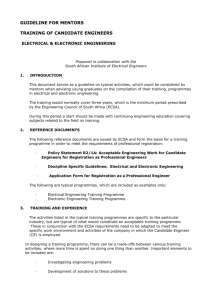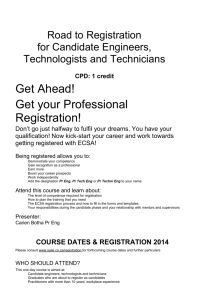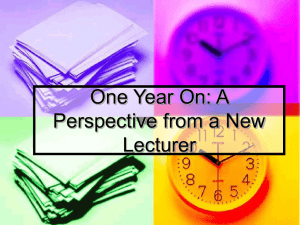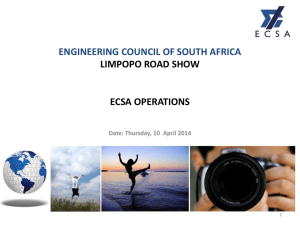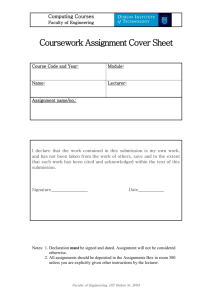Monitoring workplace learning as means towards international
advertisement
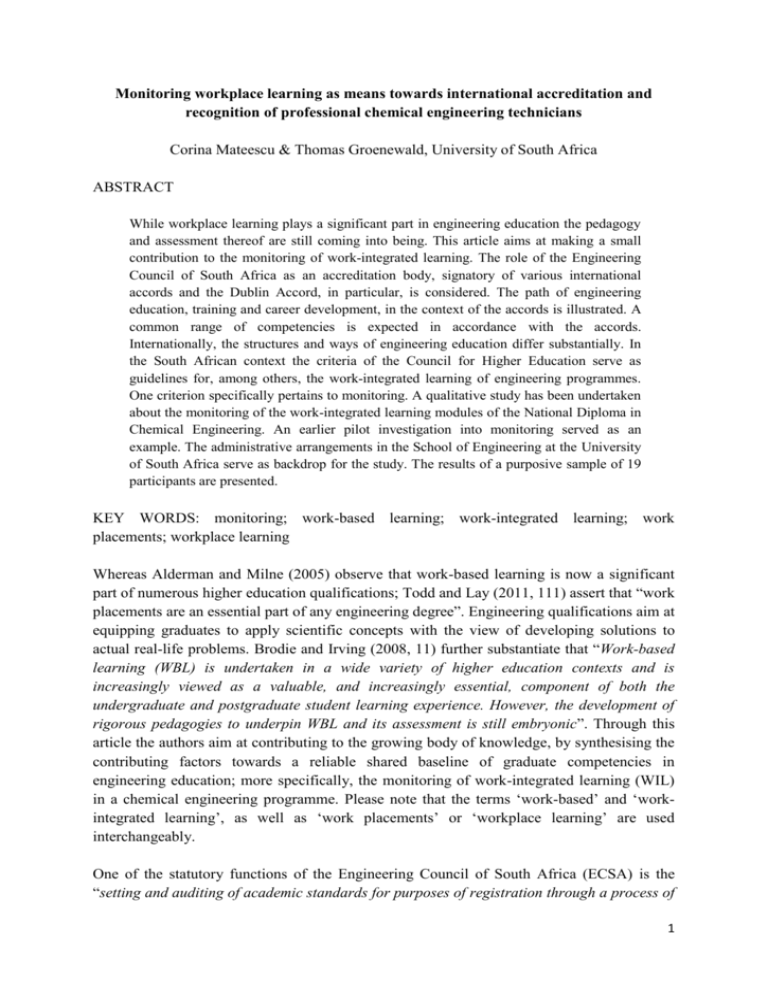
Monitoring workplace learning as means towards international accreditation and recognition of professional chemical engineering technicians Corina Mateescu & Thomas Groenewald, University of South Africa ABSTRACT While workplace learning plays a significant part in engineering education the pedagogy and assessment thereof are still coming into being. This article aims at making a small contribution to the monitoring of work-integrated learning. The role of the Engineering Council of South Africa as an accreditation body, signatory of various international accords and the Dublin Accord, in particular, is considered. The path of engineering education, training and career development, in the context of the accords is illustrated. A common range of competencies is expected in accordance with the accords. Internationally, the structures and ways of engineering education differ substantially. In the South African context the criteria of the Council for Higher Education serve as guidelines for, among others, the work-integrated learning of engineering programmes. One criterion specifically pertains to monitoring. A qualitative study has been undertaken about the monitoring of the work-integrated learning modules of the National Diploma in Chemical Engineering. An earlier pilot investigation into monitoring served as an example. The administrative arrangements in the School of Engineering at the University of South Africa serve as backdrop for the study. The results of a purposive sample of 19 participants are presented. KEY WORDS: monitoring; work-based learning; work-integrated learning; work placements; workplace learning Whereas Alderman and Milne (2005) observe that work-based learning is now a significant part of numerous higher education qualifications; Todd and Lay (2011, 111) assert that “work placements are an essential part of any engineering degree”. Engineering qualifications aim at equipping graduates to apply scientific concepts with the view of developing solutions to actual real-life problems. Brodie and Irving (2008, 11) further substantiate that “Work-based learning (WBL) is undertaken in a wide variety of higher education contexts and is increasingly viewed as a valuable, and increasingly essential, component of both the undergraduate and postgraduate student learning experience. However, the development of rigorous pedagogies to underpin WBL and its assessment is still embryonic”. Through this article the authors aim at contributing to the growing body of knowledge, by synthesising the contributing factors towards a reliable shared baseline of graduate competencies in engineering education; more specifically, the monitoring of work-integrated learning (WIL) in a chemical engineering programme. Please note that the terms ‘work-based’ and ‘workintegrated learning’, as well as ‘work placements’ or ‘workplace learning’ are used interchangeably. One of the statutory functions of the Engineering Council of South Africa (ECSA) is the “setting and auditing of academic standards for purposes of registration through a process of 1 accreditation of engineering programmes”. A webpage, ‘Education: Qualifications Recognised’, of the ECSA spells out the common need of countries for engineering services. The page further points out that it is increasingly being recognised that engineering competencies share a common baseline. Although detailed knowledge and local contexts may vary, the engineering professions, individuals in particular, are highly mobile. In the interest of international common minimum standards and the recognition of one another’s qualifications; countries entered into various agreements, such as the Washington Accord— 1989, the Sydney Accord—2001 and the Dublin Accord—2002 (Engineering Council, ECSA, International Engineering Alliance, Todd & Lay 2011). The ECSA participates in benchmarking and monitoring co-signatories to these accords periodically. Another ECSA webpage, ‘About ECSA: What Is ECSA?’ states that the ECSA’s mandate, as statutory body, rests with the Engineering Profession Act 2000 (46 of 2000). Although accountable to government, the engineering profession and the public; ECSA is fully autonomous. ECSA, among others, collaborates in promoting a high level of education, training, and professionalism in the engineering profession; both nationally and internationally. Table 1 portrays the types of South African higher education engineering programmes that are accredited with ECSA, which also enjoy recognition by fellow accordsignatory countries. The qualification-type requirement of the three categories of engineering professionals is indicated. The ECSA document that provides further details is referenced. Table 1: ECSA accredited qualification-types and registration categories according to accords ECSA require to register as Professional Engineer Qualification type/s Study duration Accord ECSA document reference BEng, BSc(Eng) and BIng Four years Washington E-20-PE, Revision 17, 30 November 2011 Professional Engineering Technologist BTech One year (post National Diploma) Sydney E-20-PT, Revision 8, 21 November 2012 Professional Engineering Technician National Diploma Three years, including two academic and one experiential training Dublin E-20-PN, Revision 6, 21 November 2012 The Dublin Accord is of importance for the purposes of this article. Currently the Dublin Accord has eight signatories, namely Australia, Canada, Ireland, Korea, New Zealand, South Africa, United Kingdom and the United States (International Engineering Alliance n.d.). It is an agreement that serves the purpose of international recognition of qualifications underpinning the registration of engineering technicians. Just over a decade ago, May 2002, 2 the engineering bodies of four countries entered into the agreement of mutual recognition. The countries were Canada, the Republic of Ireland, South Africa and the United Kingdom. In order to facilitate the mobility of the three categories of engineering practitioners mentioned in table 1, the three accords are multi-lateral agreements voluntarily entered into by the jurisdictional agencies of countries responsible for accreditation or recognition of tertiary-level engineering qualifications to assist in growing globalisation. The members demonstrate their commitment to the development and recognition of good practice in engineering education by being signatories (IEA 2012). Admissions of new signatories to the Dublin Accord require two nominators, and a two-thirds majority of current signatories. A prescribed period of four years, during which comprehensive examination is undertaken, is further required. Amendment of the Dublin Accord requires a unanimous agreement of all the signatories; and the amendment of the rules and procedures a two-thirds majority. A full year notice is required for resignation. Todd and Lay (2011, 111) indicate that the accords imply that accredited qualifications would “give engineering graduates a range of [expected] competencies”. They continue to remark that “while the majority of competencies can be met by academic coursework and projects, university education tends to be somewhat distant from typical engineering practice and settings”. This, unfortunately, means that students are likely to obtain minimal to no “feel for working in the engineering profession”. Todd and Lay (2011), therefore, argues that gaining “work experience during an engineering degree [or diploma] is important in integrating and embedding knowledge gained at university with industry”. During work-integrated learning students also get the opportunity to develop many soft skills that are not necessarily being taught at university and to acquire a feel for what it is like working in the engineering field. Figure 1 illustrates the education, training and continued professional development paths based on the accords. The two upward chevron-shapes at the bottom of the figure, suggest two qualifications accredited by different signatories to the accord. Both are considered acceptable—because of their substantial equivalence—in preparing graduates for entering formative development, for registration. Todd and Lay (2011) report that, internationally, the structures of engineering cooperative programmes vary significantly in that some have formalised alternating schedules—called sandwich programmes whereas others make use of summer-holiday placements. In some instances students work part-time while studying; while others have one or more work-terms midway in the programme. Todd and Lay (2011, 118–120) present a best practice case study in which engineering students register in their second year of study for both a pre-placement paper/module/subject and a placement paper. During the third year of study, students register for a post-placement paper and a second placement paper. A resource fee is payable by students for each of the four papers. The pre-placement paper includes CV-writing skills; how to approach interviews; an introduction into reflective practice on experiences; and how to set learning objectives. If students do not succeed in securing a placement, they are refunded with the placement paper fees and may re-register the following year. The postplacement paper focuses on reflective practice and producing portfolios of learning evidence. 3 Engineering practice Training and experience Graduate attributes: indicating that qualification objectives are satisfied Observing the code of conduct and maintain competence Meeting the standards for professional competency Meeting the standards for engineering education Accredited qualification of accord signatory A Accredited qualification of accord signatory B Substantial equivalence Figure 1: Illustration of the engineering path of education, training and continued professional development (based on a combination of the International Engineering Alliance, 2011, slides 4 & 9) Groenewald (2009) points out that in the South African context, the Higher Education Quality Committee (HEQC), which is a permanent structure of the Council on Higher Education (CHE), published two sets of criteria in 2004 one for institutional audits and one 4 for programme accreditation. The CHE is an independent statutory body which is responsible for advising the South African Minister of Education about higher education policy matters. The HEQC, led by an executive director, has executive responsibility for quality promotion and quality assurance of all higher education institutions. The HEQC’s work-based learning criteria, in summary, include: Ensuring adequacy of staffing for WBL, and the effectiveness of management and coordination of WBL, in terms of criterion 1 (CHE 2004b, 8, ix) and 15 (CHE 2004b, 20, 3.2.1.5) for programme accreditation purposes. In accordance to criterion 1 (ix, p. 8) and 15 (3.2.1.5, p. 20) for programme accreditation and criteria 7,8 & 11 for institutional audits , quality with regard to: o Promoting the understanding of students about the specific occupation they are being trained for (CHE 2004b, 8, criterion 1[ix]). o Students mastering the techniques and skills required for the occupation. o WBL forming an integral and essential part of the curriculum (CHE 2004a, 1112, criterion 8). o WBL contributing to achieving the purposes of the programme/qualification (CHE 2004b, 16-17, 3.2.12). o The learning contracts/agreements with experiential learning providers are clarifying the objectives and outcomes of WBL, the respective roles and responsibilities (CHE 2004b, 20, 3.2.1.5, criterion 15, and CHE 2004a, 10-11, criterion 7). o Mentoring of each student, which helps students to recognise their strengths and weaknesses; develop their existing and new abilities; and gain work practice knowledge. o Regularity and effectiveness of communication between WBL parties. o Progress in monitoring and recording systems. o Workplace assessment (CHE 2004a, 14, criterion 11). With regard to monitoring and assessing workplace learning, Muscat and Mollicone (2012) report that examinations were traditionally mainly used as method at the University of Malta to gauge the progress and achievements of undergraduate engineering students with regard to their ability to come up with a solution to a given problem while under pressure, which is regarded as an important characteristic of engineering practitioners. However, Muscat and Mollicone (2012, 66), recognise that examinations do not necessarily assess important characteristics such as “making appropriate assumptions to solve a problem; using a bottomup approach to problem solving; thinking laterally about a problem; making a connection between the problem in hand and fundamental theories; and the ability to work in groups”. This is where monitoring students during work-integrated learning by the relevant lecturer and assessment by workplace mentors and supervisors play an important role in the overall evaluation the competence of students. Groenewald (2009, 78-79), based from literature reviews, points out two ends of a continuum regarding to the focus of assessment and monitoring, namely competence and capabilities; and that elements from both ends of the spectrum may well be included. 5 This literature review started with the significance of workplace learning for engineering qualifications. It then portrayed the statutory role of the Engineering Council of South Africa and the international accords to ensure common minimum standards that would enable mobility between signatory countries. The Dublin Accord is of particular importance to engineering technicians. The literature reviews pointed out the differences in the structure of engineering programmes. The South African higher education quality criteria were focussed on and concluded specifically with monitoring. The literature reviews contextualised the research undertaken. The methodology follows here after, then the findings, and a discussion of the results concludes the article. METHODOLOGY Substantial transition took place since Tesch (1990, 1) remarked that “there was a time when most researchers believed that the only phenomena that counted in the social sciences were those that could be measured”. More than two decades later, Chilisa (2012, xv) asserts that “the community of social science researchers is experiencing a struggle as it comes to terms with social justice issues that arise from the research process itself”. Chilisa (2012, 7) cautions that researchers “have the power to label, name, condemn, describe, or prescribe solutions”, and attempts to sensitise researchers not to perpetuate selfserving research paradigms. Chilisa (2012, 2) describes a paradigm as “a methodological approach with a philosophical base that informs assumptions about perceptions of reality, what counts as knowledge and ways of knowing and values”. The impact on the way in which research questions are conceived; the research approaches adopted; the nature of the data gathering instruments; how data analysis and interpretation is done; and also how research findings are disseminated. Chilisa (2012, 7 and 22), therefore, urges researchers to be “guided by the four Rs: [relational] accountable responsibility, respectful representation, reciprocal appropriation, and [the] rights and regulations of the researched” and to adhere to ethical guidelines and protocols. Relational accountability implies the accountability of the researcher that all parts of the research process are related. Respectful representation entails how the researcher creates space for the voices of the researched to emerge; and how the researcher attends and recognises the voices of the researched. Reciprocal appropriation means that both the researched and researcher derive benefits. Background and overview The work-integrated learning modules of the National Diplomas offered by the School of Engineering, in the College of Science, Engineering and Technology (CSET), at the University of South Africa (Unisa) are year modules. Students may start registering near the end of November until before Christmas, the previous year and from the first full week in January until the end of February of the year in which they intend doing the module/s. Students may only register for the first work-integrated learning module after they successfully completed ten academic modules (96 credits obtained). Furthermore, they may only register for the second work-integrated learning module if 15 academic modules have 6 been completed. These conditions are applied to ensure that students have acquired an adequate academic frame of reference in order to relate work experience to. The tendency at South African residential universities of technology (UoTs) and comprehensive universities is to ‘label’ the academic or ‘theoretical’ semesters T1 to T4. Work-integrated learning, in turn, has long generally been known as P1 and P2, for practical semester 1 and 2 respectively. The established term, commonly used in industry, is experiential learning, rather than work-integrated learning. Figure 2: An example of the pop-up that appears when a student wants to register for a work-integrated learning module When a student enters the code of a work-integrated learning module (‘P1 or P2’) for registration, it triggers a pop-up that forms part of the Unisa registration system. Refer to figure 2 for an image of the pop-up and not the three response items. One of the items must be picked for the student to proceed with registration for the module. The data captured— Yes, Uncertain, or No—in this way enables the lecturer to get an overview of the employment or placement of students for the specific module. A sequel report format exists to enable the lecturer to extract the information on demand. The report’s column headings include: STUDENTNR The student’s Unisa number PLACEMENT The response given by the student to the pop-up STUDENT Student’s surname; initials & title MODULE The relevant module code HOME Home telephone number on the Student Administration System WORK Work telephone number on the Student Administration System CELL Cellphone number on the Student Administration System EMAIL_ADDRESS Student’s e-mail address on the Student Administration System REGION Based on postal code, the Unisa regional office allocated to ADDRESS_LINE_1 Address captured on the Student Administration System ADDRESS_LINE_2 ADDRESS_LINE_3 ADDRESS_LINE_4 POSTAL_CODE D & DISABLEMENT Code and description of student’s self-disclosed disability 7 The report mentioned above can be manipulated as required in Microsoft Excel, for example by sorting the responses about placement. The self-disclosed disability columns further enables the lecturer to accommodate the specific needs a student may have. Unisa is required to furnish the South African Department of Higher Education and Training with evidence that students are indeed active. The institution decided in 2005 that the submission of assignments will serve as a means towards this end. If a student is employed (studying with the view of career advancement) at the time of registration; or if a student acquired a placement with a suitable (and preferably accredited) company to gain the relevant work experience, the student submits the first ‘assignment’. This entails confirmation of the organisation, its contact details, and the qualifications and experience of the mentor. The information submitted is scrutinised by the lecturer, suitability assessed and the data captured. The lecturer modified the format of the report mentioned above to capture the core data contained in ‘assignment’ submitted by students. The modified Microsoft Excel spread sheet serves as the lecturer’s management tool. The column headings therefore include: Student’s surname and initials Student number Company's name where employed or based for work-integrated learning City — important for the lecturer’s geographical location purposes Telephone number Cellphone number Mentor’s name Mentor’s Engineering Counsel of South Africa registration Assignment 01 Assignment 02 Assignment 03 Student’s final submission for assessment Date of monitoring visit Email address of student About mid-year, a progress report (‘Assignment’ 02) is submitted, which ideally must be verified by the workplace mentor. If a student only succeeds in securing a placement by about mid-year, ‘Assignment’ 01 is submitted and ‘Assignment’ 02 about three months later. Once ‘Assignment’ 02 is received, it signals time to monitor the student in situ and assess the quality of the work-integrated learning. By examination time (October – November) ‘Assignment’ 03 is submitted for assessment which typically includes a file containing the portfolio of ‘evidence’ of learning, the student’s project (where applicable), the learning logbook, and the mentor’s report. After assessment, the lecturer adds the student’s monitoring report and submits the student’s final mark for the module. If a student only acquired a suitable placement well into the year, extension is 8 normally granted and ‘Assignment’ 03 submitted in about January the following year when the supplementary examinations are written. Population An analysis of the data from the registration report executed and the lecturer’s own spread sheet for management is presented in table 2, which is divided into two to represent the data of each module. The reason for the difference in numbers of the two sets of data is because not all students that registered for 2013 submitted assignments. A total number of 88students registered for one or both work-integrated learning modules. This number represents the total potential population. Table 2: The 2013 population of Chemical Engineering WIL module registrations Chemical Engineering Practice 1 Chemical Engineering Practice 2 Placed Uncertain 57 11 Total: 92 Need place At a company 24 60 15 Total: 75 ‘No job’ Placed Uncertain 37 11 Total: 48 Need place At a company 6 34 — Total: 34 ‘No job’ Preparation The lecturer approached preparation for monitoring keeping in mind of the lessons derived from and the guidelines established during a monitoring pilot undertaken (Groenewald 2009, 81-85) and the contemporary qualitative research paradigm outlined above. The document (based on Groenewald 2009, 84), which serves as a structured interview schedule (Chilisa 2012, 205; Schurink 1998, 299) used for monitoring, includes: Identification details of the student to be monitored Identification details of the work-integrated learning site Basic details of the workplace mentor Documented work-integrated learning experienced by the student concerned Student’s progress documented over against a checklist A summary of the discussion with the workplace mentor (or supervisor) and the lecturer’s observations A summary of the interview with the student and the lecturer’s feedback Notes on any observations about developments in the field concerned that might influence future work-integrated learning of the qualification concerned In order to be sure of the locality and routes to the workplaces where students had to be monitored, the lecturer employed Google Maps for GPS coordinates, directions and on route photos. In some cases specific maps and GPS coordinates were acquired or provided. In one case the lecturer experienced difficulty in finding the organisation because the specific street name is used in both a residential suburb and the industrial area. In another case the main route had been closed and the lecturer had to follow a detour. 9 Many chemical plants have strict safety and/or security protocols. In one case it resulted in the lecturer being late, because she had to sit through a safety induction first and pass a test prior to be permitted into the plant for the monitoring visit. Security scanning further presented challenges in that only underwear without metal is permitted and documents must be without any staples or clips. RESULTS Sample The sample could be described as purposive, but also as accidental, intensified or targeted. Strydom and De Vos (1998, 198) describe purposive sampling as “based entirely on the judgement of the researcher”. They further state that such a sample “is composed of elements which contain the most characteristic, representative or typical attributes of the population”; a notion supported by Henning, van Rensburg and Smit (2004, 71) who qualify it as “people who fit the criteria of desirable participants”. Chilisa (2012) also clarifies a purposive sample as people identified because of their relevance to the researcher’s area of interest. The lecturer decided to include all the monitoring visits of 2013 in the sample, which is an example of a purposive sampling decision. According to Strydom and De Vos (1998, 198), an accidental sample “happens to cross the researcher’s path”, which describes the self-exclusion of potential participants in that the lecturer only intended to visit those students who submitted their second assignment for monitoring. Chilisa (2012, 170) qualifies intensified sampling as “individuals … selected in which the phenomenon of interest is strongly represented”, namely students who progressed to make their monitoring visit worthwhile. According to Strydom and De Vos (1998, 199), target sampling is a strategy which is purposeful and systematic, whereby “controlled lists of specified populations within geographical districts are developed”. Challenges that face the lecturer restricted the sample; in that there are prescribed procedures regarding travelling arrangements at Unisa. Some students did not give sufficient advanced notice in order to arrange for transport; whereas others cancelled a last minute, making alternative travelling arrangement unfeasible. The documentation of 19 monitoring visits served as sample for this research exercise. Visits were paid to three of the provinces of South Africa. Two visits paid to KwaZulu-Natal, one each at Jacobs, near Durban and at one to Petermaritzburg. Two visits paid to Rustenburg, in the North-West province. The remaining 15 visits required substantial travelling in the Gauteng province. Visits to the north of Gauteng were paid to Pretoria, Samrand and Centrurion. Visits to the west of Gauteng were paid to Chamdor and Krugerdorp. Visits to the east of Gauteng were paid to Springs, Boksburg, Kempton Park and Moderfontein. Visits paid to the greater Johannesburg Metropolitan included Bruma, Claeville and Cleveland. Ethics Neither students, nor mentors were informed about the research, because it is believed that informing them might have adversely influenced the results. However, no personal or 10 company identifying data are divulged. The research is restricted to the monitoring visits as such. Findings Henning, van Rensburg and Smit (2004, 101) state that “the true test of a competent qualitative researcher comes in the analysis of the data, a process that requires analytical craftsmanship and the ability to capture understanding of the data”. The lecturer captured data of each monitoring visit in the monitoring document previously piloted (Groenewald 2009). The documents were read several times by the authors, spaced over a period of time, which allowed for the data to ‘simmer’. On a specific day the ‘meaning phrases’ of each document were extracted to be considered collectively. Matching meanings, repetitions, related meanings, and so forth were identified, and data were grouped. To remain truthful to the participants their wording captured during monitoring visits was used to produce the narrative of findings. The workplace mentors had an average of 14 years of experience. Two of them (an employee and a self-employed consultant) had 40 years of experience (the highest); one had 27 years of experience (second highest); another one had four years of experience (the lowest); and there was one who had five years of experience (second lowest); the remainder varied from eight to10, 2x 12, 4x 13 and 1x 14. There was no indication in respect of two of the mentors. Unfortunately, the monitoring visits of four (4 = 26.6%) students did not allow for interviewing the workplace mentor. In one case the mentor’s sick leave was extended, resulting in it only feasible for the lecturer to speak to the supervisor. In another case the mentor worked afternoon shift — and the lecturer got the impression that the student did not realise the importance of interviewing the mentor. In the third case, the student did not inform the lecturer of a change in mentor. In the final case the mentor was called out of the office due to an unexpected event which required attention. Several mentors used the intensifier ‘very’ to give expression to their feedback about the student, for example: ‘Very good’, or ‘very good attitude towards work’ (also ‘passionate’ and ‘committed’) ‘Very happy with the student’, and ‘really very happy with the student’s progress’ A very good student ‘Very helpful and keen to contribute’ (and ‘adds value to the company’) ‘Very hardworking’ (also ‘doing a great job’ and ‘work up to standard’) ‘Very energetic and exited’ (and ‘always keen to learn’) ‘Very friendly’ ‘Very trustful’ ‘Very accurate and precise’ One mentor used the intensifier ‘too’, saying ‘the student is sometimes too inquisitive’ 11 Another theme expressed by several mentors is ‘growth’ of the student, or that the student has ‘grown’ or ‘grown up’ or ‘grown self’. In one case the mentor remarked that the student was initially very ‘bumpy’ and shy, but has overcome those and is now a brilliant student. Several students either advanced in the company; and were given the opportunity to study with the company; or acquired expertise since they commenced working for the company. Associated with this theme are comments about having ‘gained confidence’; and that maturity is often reflected in commitment and passion. A comment about an older student is that ‘she is not one of them’, differentiating her from the attitude young students often display. One person has already advanced to deputy director of the company with proven competence and substantial responsibilities. A third theme related to the commentary of mentors about students is ‘keenest to learn’; with comments such as ‘ask whenever there is a need for explanation’; ‘always asking questions relevant to her work’; ‘inquisitive’; and even tenacity—‘would not stop until mastery’. A mentor expressed admiration that the student is willing to work without pay for six months in order to gain the required experience. Another mentor expressed approval of the student’s implementation of ideas. The monitoring visit of four (5 = 26%) students included a chemical plant tour offered by the students. The lecturer had been impressed by the student’s plant and/or process knowledge; the detail of explanations; and the demonstrated understanding of the engineering behind the processes. Two students were capable of running the plants on their own. One visit took more than four hours from induction to exit, because of the distance between the units that required a lot of walking, which was exacerbated by the temperature of above 30°Celcius. One mentor was ‘very impressed with the workplace visit by the university’ and said ‘he wished when he was a student his lecturers came and visit him when he was a student’. Some students also made use of the intensifier ‘very’ to give expression to their workintegrated learning, with wording such as ‘very good learning experience’; ‘very thankful/grateful to the company for providing the opportunity’ or allowing him to continue his studies; and ‘very happy in this workplace’. Expressions associated with this theme included ‘learned a lot’, ‘excited about the experience’, ‘happy with the support of mentors and colleagues’, and also an expression of ‘enjoyment of the work’. An encouraging theme that emerged is that at least three students acquired permanent positions as a result of their work-integrated learning. A third student, who initially wanted to quit, not only got an increase in salary, but her circumstances changed to the better. The lecturer persuaded the student not to quit when she wanted to. It transpired, quite interestingly, that two students were serving as mentors; one for a residential student from a university of technology; and the other for full-time students undergoing stints of experience. In both cases the students serving as mentors had several 12 years of experience with the company. The ‘growth’-theme that emerged from mentor feedback, is mirrored by a theme that emerged from feedback from students, namely ‘now understanding theory’ and ‘understanding the process very well’. One student remarked that he first gained practical experience and then theoretical knowledge. One student revealed that he is piloting a plant to test the improvement of water treatment; which is quite encouraging. Unfortunately the lecturer also picked up less encouraging issues. In one case the mentor expressed that the student needed to show more initiative about his university studies, although mitigated that the student’s work in the plant is good. In this particular case the lecturer returned the student’s submitted portfolios, due to a lack of learning evidence. One company is perceived ‘not to be open to take students’ and has no internal coordination of work-integrated learning. One student previously worked at another plant where she did not learn much, but fortunately got a better placement. One company was prepared to take students, but only those sponsored the Chemical Industry Education and Training Authority (CHIETA). One of the mentors expressed an interest in Unisa’s master degree programmes in order to further his/her own studies. This is an example of additional benefits derivable by the university as result of monitoring visits conducted in the workplace. Apart from the few discouraging issues, and the additional benefits gained through the monitoring visits; a number of themes emerged, namely: Both mentors and students made use of the intensifier ‘very’ to convey their feedback Mentors observed growth and students reflected on the understanding they acquired Most mentors remarked on students who were keen to learn There is evidence of personal benefit derived from workplace learning DISCUSSION Although rigorous pedagogies may not yet exist, the research serves as anecdotal evidence for workplace learning in that learning does take place; students do experience growth; and students do derive career development and/or substantive appointments as a result of their workplace learning performance. During accreditation visits, the Engineering Council of South Africa (ECSA) accreditation teams do review the documentation of the monitoring visits. The documentation includes the checklist of the tasks comprising each of the work-integrated learning modules. In this way ECSA goes some way towards its role as signatory of the Dublin Accord. It is recognised that this research is merely an entry into the topics of monitoring and of international accreditation. It is therefore suggested that this research is extended to other 13 engineering disciplines, as well as repeated in chemical engineering, in order to gather more qualitative data and finding more themes. There after a questionnaire could be developed, administered with regard to monitoring, and hypotheses tested. Project could further be conceived to research some or several of the criteria espoused about work-integrated learning by the South African Council for Higher Education (CHE). REFERENCES Alderman, B. and Milne, P. 2005. A model for work-based learning. Metuchen, NJ: Scarecrow Pr. Brodie, P. and Irving, K. 2007. Assessment in work-based learning: investigating a pedagogical approach to enhance student learning. Assessment & Evaluation in Higher Education, 32(1), 11-19. Chilisa, B. 2012. Indigenous research methodologies. Los Angeles: SAGE. Council for Higher Education. 2004a. Higher Education Quality Committee. Criteria for Institutional Audits. Pretoria: Compress. Electronically available from http://www.che.ac.za/sites/default/files/publications/CHE_Institutional-AuditCriteria_June2004.pdf Council for Higher Education. 2004b. Higher Education Quality Committee. Criteria for Programme Accreditation. Pretoria: Compress. Electronically available from http://www.che.ac.za/sites/default/files/publications/CHE_accreditation_criteria_Nov2004_0. pdf ECSA refers to Engineering Council of South Africa Engineering Council. s.a. – sine anno, meaning without a year. International Recognition Agreements. Electronically accessed 16 September 2013 from http://www.engc.org.uk/education--skills/international-recognition-agreements Engineering Council of South Africa. s.a. About ECSA: What Is ECSA? Electronically accessed 16 September 2013 from http://www.ecsa.co.za/index.asp?x=ecsa Engineering Council of South Africa. s.a. Education: Qualifications Recognised. Electronically accessed 16 September 2013 from http://www.ecsa.co.za/index.asp?x=qualrecognised Engineering Council of South Africa. s.a. Education: Recognition of South African Qualifications. Electronically accessed 17 September 2013 from http://www.ecsa.co.za/index.asp?x=saquals#SAY 14 Engineering Council of South Africa. s.a. Statutory Functions. Electronically accessed 23 December 2013 from https://www.ecsa.co.za/about/SitePages/Statutory%20Functions.aspx Engineering Council of South Africa. 2011. Strategic Plan 1 April 2010 – 30 March2014, version 1.4, 17 March 2011. Electronically accessed 16 September 2013 from http://www.ecsa.co.za/documents/ECSA_Strategic_Plan_2010_to_2013.pdf Engineering Council of South Africa. 2011. University degrees accredited as meeting the educational requirement for registration as a professional engineer, Document E-20-PE, Revision 17, 30 November 2011. Electronically accessed 17 September 2013 from http://www.ecsa.co.za/documents/List_of_AccrUniv_E-20_PE_2011.pdf Engineering Council of South Africa. 2012. Degrees accredited as meeting the educational requirement for registration as a candidate or professional engineering technologist, Document E-20-PT, Revision 8, 21 November 2012. Electronically accessed 17 September 2013 from http://www.ecsa.co.za/documents/List_of_AccrBTech_E-20_PT_2012.pdf Engineering Council of South Africa. 2012. Diplomas accredited as meeting the educational requirement for registration as a candidate and professional engineering technician, Document E-20-PN, Revision 6, 21 November 2012. Electronically accessed 17 September 2013 from http://www.ecsa.co.za/documents/List_of_AccrNDip_E-20_PN_2012.pdf Groenewald, T. 2009. Lessons derived from a work-integrated learning monitoring pilot at a distance higher education institution. Asia-Pacific Journal of Cooperative Education, 10(2), 75-98. Electronically accessed 16 October 2013 from: http://www.apjce.org/files/APJCE_10_2_75_98.pdf Henning, E., Van Rensburg, W. and Smit, B. 2004. Finding your way in qualitative research. Pretoria: Van Schaik. Muscat, M. and Mollicone, P. 2012. Using Kolb's learning cycle to enhance the teaching and learning of mechanics of materials. International Journal of Mechanical Engineering Education, 40(1), January 2012. Electronically accessed 30 September 2013 from httpÄ.doi.org/10.7227/IJMEE.40.1.10 IEA refers to International Engineering Alliance International Engineering Alliance. 2013. Graduate Attributes and Professional Competencies, Version 3, 21 June 2013. Electronically accessed 16 September 2013 from http://www.ieagreements.org/IEA-Grad-Attr-Prof-Competencies.pdf 15 International Engineering Alliance. 2012. International engineering alliance: educational accords — Accord rules and procedures, June 2012. Electronically accessed 17 September 2013 from http://www.ieagreements.org/Rules_and_Procedures.pdf International Engineering Alliance. 2011. The Washington Accord Past, Present, Future. Presentation at the IEET Accreditation Training, in Taipei, in September 2011, by Hu Hanrahan. Electronically accessed 16 September 2013 from http://www.washingtonaccord.org/washington-accord/Washington-Accord-Overview.pdf International Engineering Alliance. s.a. Dublin Accord introduction. Electronically accessed 17 September 2013 from http://www.ieagreements.org/dublin/ International Engineering Alliance. s.a. Introduction. Electronically accessed 16 September 2013 from http://www.washingtonaccord.org/ Schurink, E.M. 1998. The methodology of unstructured face-to-face interviewing. In A.S. De Vos (Ed). 1998. Research at grass roots, a primer for the caring professions. (pp 297-333) Pretoria: Van Schaik. Strydom, H. and De Vos, A.S. 1998. Sampling and sampling methods. In A.S. De Vos (Ed). 1998. Research at grass roots, a primer for the caring professions. (pp 189-201) Pretoria: Van Schaik. Tesch, R. 1990. Qualitative research: analysis types and software tools. New York: The Falmer Press. Todd, A.M. and Lay, M. 2011. Cooperative and work-integrated education in Engineering. In R.K. Coll and K.E. Zegwaard (Eds.) International handbook for cooperative and workintegrated education (2nd ed.), pp. 111 – 121, World Association for Cooperative Education Inc. 16
